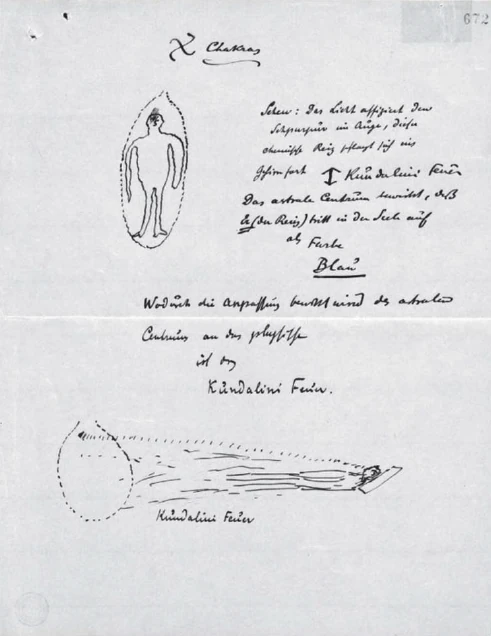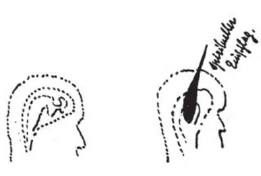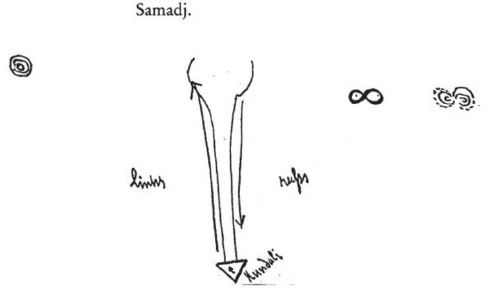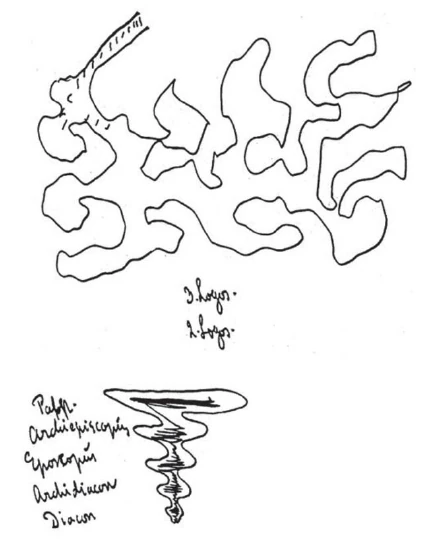Soul Exercises I
Word and Symbol Meditations
GA 267
Translated by Steiner Online Library
Some Notes on “Lotus Flowers - Chakras” “Kundalini”
For more information on this content, see the publisher's comment on p. 523.
The effect of all earthly activity on the astral body:
This earthly activity refers to the formation of lotus flowers by humans themselves.
Four-petaled lotus flowers: external sciences: raven
Six-petaled lotus flowers: psychology: sensual moral effect of color: occult
Eight-petaled lotus flowers: history: warrior
Twelve-petaled lotus flowers: religious studies: lion
Sixteen-petaled lotus flowers: theosophy: with the name of the race; sun hero
Two-petaled lotus flowers: Theurgy: Father
The apprentice is the embryo of the astral body, and Mother Earth carries him.
The apprentice seeks to understand what humanity has accomplished thus far.
Learning causes the lotus flower, which was previously only sensitive, to become volitional.
Samadhi:e.g. concentration on the will: distraction of the mental image so that, with complete consciousness, the mind is immersed in the will without any mental image.
[Samadhi - Sanskrit for “being firmly joined together,” collection, concentration]
When the lotus flowers are formed
without an influence of wisdom: AhrimanicWhen mobility is developed
without moral influence: Luciferic
Luciferic: the lotus flowers function, but they turn only to what is in accordance with the personality; they turn toward their own Ahrimanic element.
This physical body is built up by the forces of the
astral body; it develops into
the sense organs. These — the eyes — see
objects through the sunlight from outside.One must distinguish a second half within the astral body itself: [drawing]
like the other pole in a magnet.In men, the second astral body is female;
in women, the second astral body is male,
which means that the astral body is hermaphroditic.The kundalini fire is now the activity aroused in the second
astral body, which is initially
heat and light.As long as the kundalini fire is not aroused,
one gropes between the objects
and beings of the higher world, as in the
night between physical objects.
When the Kundalini fire is present, one illuminates
oneself and the objects."

Transcription: Seeing: Light affects the purple part of the eye, this chemical stimulus propagates itself to the brain Kundalini fire The astral center causes it (the stimulus) to appear in the soul as the color blue
The kundalini fire causes the astral center to adapt to the physical center.

A kind of mental cavity is created; the cavity is created by the content of meditation. When the content of meditation is let go, content from the spiritual sphere can enter. Maintenance of the functions of thinking without the content of thinking.

Activity: Will
Passivity: Thinking
Passive thinking is observation, i.e., the representation of content that is foreign to it.
Active will is action, i.e., the realization of one's own content.
At the moment of Kundali's awakening, passive thinking becomes active
and active will becomes passive
The moment of awakening can be described as the moment when the being acquires active, i.e., productive thinking and passive, i.e., receptive will.
Think of the result of productive thinking as a sum of thought forms:

3. Logos - 2. Logos
Pope - Archiepiscopus - Episcopus - Archidiacon - Diacon
Einige Blätter mit Notizen zu «Lotusblumen - Chakras» «Kundalini»
Die Wirkung alles Erdentreibens auf den Astralkörper:
Dieses Erdentreiben bedeutet die Bildung der Lotusblumen durch den Menschen selbst.
Vierblätrige Lotosblumen: äußerenWissenschaften: Rabe
Sechsblättrige Lotosblumen: Psychologie: Sinnlich sittliche Wirkung der Farbe : Okkulter
Achtblättrige Lotosblumen: Geschichte: Streiter
Zwölfblättrige Lotosblumen: Religionsstudium: Löwe
Sechzehnblättrige Lotosblumen: Theosophie: mit dem Namen der Rasse; Sonnenheld
Zweiblättrige Lotosblumen: Theurgie : Vater
Der Lehrling ist der Embryo des Astralleibes und es trägt ihn aus die Mutter Erde.
Der Lehrling holt erkennend nach, was die Menschheit bisher gearbeitet hat.
Das Lernen bewirkt, daß die betreffende Lotusblume, die vorher bloß sensitiv war, willensartig wird.
Samadhi:
z. B. Konzentration auf den Willen: Ablenkung der Vorstellung, sodaß bei völligem Bewußtsein der Geist ohne Vorstellung in den Willen versenkt
[Samadhi - Sanskrit für «Fest-zusammen-gefügt-Sein», Sammlung, Konzentration]
Wenn die Lotosblumen ausgebildet werden
ohne Weisheits Einschlag : ahrimanischWenn die Beweglichkeit ausgebildet wird
ohne moralischen Einschlag : luziferisch
Luziferisch: die Lotosblumen funktionieren, aber sie wenden sich nur allem zu, was der Persönlichkeit gemäß ist; sie wenden sich nach dem eigenen ahrimanischen Element.
Dieser physisch Körper wird durch die Kräfte des
Astralkörpers aufgebaut; er bringt es bis
zu Sinnesorganen. Diese - Augen - sehen die
Gegenstände durch das Sonnenlicht von außen.Man muß im Astralkörper selbst eine
zweite Hälfte unterscheiden: [Zeichnung]
wie der andere Pol beim Magneten.Beim Manne ist der zweite Astralkörper weiblich;
beim Weibe ist der zweite Astralkörper männlich,
das heißt der Astralkörper ist hermaphroditisch.Das Kundalinifeuer ist nun die im zweiten
Astralkörper erregte Tätigkeit, die zunächst
Wärme und Licht ist.Solange das Kundalinifeuer nicht erregt wird,
tastet man zwischen den Gegenständen
und Wesen der höheren Welt; wie in der
Nacht zwischen den physischen Gegenständen.
Ist das Kundalinifeuer da, so beleuchtet man
sich selbst die Gegenstände.»

Transkription: Sehen: Das Licht affiziert / den Sehpurpur im Auge, dieser / chemische Reiz pflanzt sich ins / Gehirn fort / Kundalini Feuer / Das astrale Zentrum bewirkt, daß / Er (der Reiz) tritt in der Seele auf / als Farbe / Blau
Wodurch die Anpassung bewirkt wird des astralen / Zentrums an das physische / ist das / Kundalini Feuer.

Es wird herbeigeführt eine Art mentaler Hohlraum; der Hohlraum wird geschaffen durch den Meditationsinhalt. Wenn nun der Meditationsinhalt fallen gelassen wird, so kann für ihn ein Inhalt aus der spirituellen Sphäre hereindringen. Beibehaltung der Funktionen des Denkens ohne den Inhalt des Denkens.

Aktivität: Wille
Passivität: Denken
Das passive Denken ist Beobachten, d. h. Abbildung eines ihm fremden Inhaltes.
Der aktive Wille ist Tun, d. h. Verwirklichung eines eigenen Inhaltes.
In dem Augenblicke der Erweckung von Kundali wird das passive Denken - aktiv
und der aktive Wille - passiv
Den Augenblick der Erweckung kann man bezeichnen dadurch, daß das Wesen ein aktives, d. h. produktives Denken und einen passiven, d. h. empfangenden Willen erhält.
Man denke sich das Ergebnis des produktiven Denkens als eine Summe von Gedankenformen:

3. Logos - 2. Logos
Papst - Archiepiscopus - Episcopus - Archidiacon - Diacon

